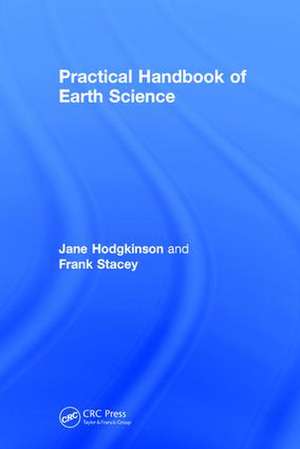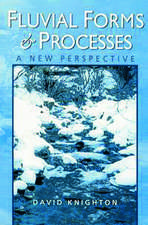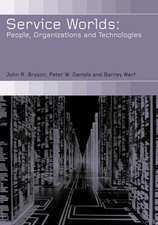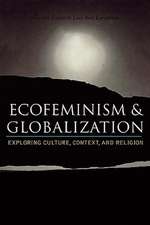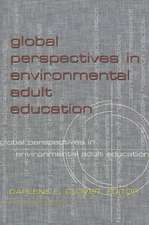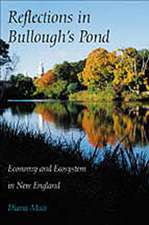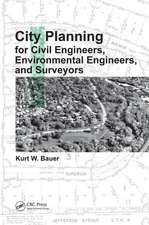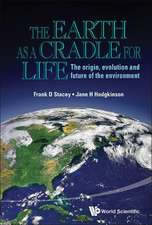Practical Handbook of Earth Science
Autor Jane Hodgkinson, Frank Staceyen Limba Engleză Hardback – 11 sep 2017
| Toate formatele și edițiile | Preț | Express |
|---|---|---|
| Paperback (1) | 705.53 lei 6-8 săpt. | |
| CRC Press – 7 sep 2017 | 705.53 lei 6-8 săpt. | |
| Hardback (1) | 882.08 lei 6-8 săpt. | |
| CRC Press – 11 sep 2017 | 882.08 lei 6-8 săpt. |
Preț: 882.08 lei
Preț vechi: 1181.96 lei
-25% Nou
Puncte Express: 1323
Preț estimativ în valută:
168.81€ • 174.39$ • 140.49£
168.81€ • 174.39$ • 140.49£
Carte tipărită la comandă
Livrare economică 26 martie-09 aprilie
Preluare comenzi: 021 569.72.76
Specificații
ISBN-13: 9781138552234
ISBN-10: 1138552232
Pagini: 420
Ilustrații: 138 Tables, black and white; 7 Illustrations, color; 39 Illustrations, black and white
Dimensiuni: 152 x 229 x 35 mm
Greutate: 0.82 kg
Ediția:1
Editura: CRC Press
Colecția CRC Press
ISBN-10: 1138552232
Pagini: 420
Ilustrații: 138 Tables, black and white; 7 Illustrations, color; 39 Illustrations, black and white
Dimensiuni: 152 x 229 x 35 mm
Greutate: 0.82 kg
Ediția:1
Editura: CRC Press
Colecția CRC Press
Cuprins
Preface. Authors. Section I: Notation And Units. Physical Units and Constants. Some Shorthand Conventions. Section II: The Building Blocks: Elements To Planets. Elements, Isotopes and Radioactivity. The Solar System. Section III: Global Geophysics. Whole Earth Properties. Section IV: Major Subdivisions Of The Earth: Structures And Properties. The Core. The Mantle. The Crust. The Oceans. Inland Salt Lakes. Fresh Water and Ice. The Atmosphere. Section V: Geological Activity: The Restless Earth. Tectonics. Earthquakes. Volcanism. Tsunamis. Weathering, Erosion, Crustal Recycling and Regeneration. Geological Time and the Fossil Record. Section VI: Rocks And Minerals. Mineral Types and Characteristics. Rock Types and Occurrences. Physical properties of Minerals and Rocks. Section VII: Resources. Elements as resources. Rocks and Minerals as Resources. Fossil fuels. Energy Sources Alternative to Fossil Fuels. Land Degradation, Waste Disposal and Recycling.References. Index.
Notă biografică
Jane Helen Hodgkinson was born and brought up in London and, following her early education, began a career in merchant banking and the commodity markets. Seeking intellectual stimulation, she undertook a degree course in geology on an evening and part-time basis at Birkbeck College, London. This was a highly successful move and she graduated with first class honours in 2003, setting herself up for her second career, as a geologist. Seeing opportunities in Australia, she undertook a PhD at the Queensland University of Technology, completed in 2008, and was appointed to CSIRO, Australia’s national science agency, as a research geologist. Much of her work has been concerned with the problems and opportunities presented to the mining industry by climate change and to a study of the CO2 geosequestration potential of Queensland geology.
Frank Donald Stacey was born and educated in London, with BSc (hons physics) 1950, PhD 1953, DSc 1968. Following appointments at the University of British Columbia, the Australian National University and the Meteorological Office research unit in Cambridge, he joined the University of Queensland, becoming Professor of Applied Physics in 1971. Since 1956, all his research has been in geophysics, initially as an experimenter in rock magnetism and subsequently in a range of other subjects, with an increasing theoretical interest. He is most widely known for his textbook, Physics of the Earth, which is now in its fourth edition. Retiring from the university in 1996, he joined CSIRO as honorary fellow, to continue fundamental research, especially applications of thermodynamics to the Earth.
This is the authors’ second joint book. The first presented a global perspective on the environment: 'The Earth as a Cradle for Life: the origin, evolution and future of the environment’ (World Scientific, 2013).
Frank Donald Stacey was born and educated in London, with BSc (hons physics) 1950, PhD 1953, DSc 1968. Following appointments at the University of British Columbia, the Australian National University and the Meteorological Office research unit in Cambridge, he joined the University of Queensland, becoming Professor of Applied Physics in 1971. Since 1956, all his research has been in geophysics, initially as an experimenter in rock magnetism and subsequently in a range of other subjects, with an increasing theoretical interest. He is most widely known for his textbook, Physics of the Earth, which is now in its fourth edition. Retiring from the university in 1996, he joined CSIRO as honorary fellow, to continue fundamental research, especially applications of thermodynamics to the Earth.
This is the authors’ second joint book. The first presented a global perspective on the environment: 'The Earth as a Cradle for Life: the origin, evolution and future of the environment’ (World Scientific, 2013).
Recenzii
"I was pleased to hear that Hodgkinson and Stacey were taking the time and effort to assemble a practical handbook on earth science, and once I had a chance to review the contents it did not disappoint. It covers a broad spectrum of physical science topics related to the earth, but focuses on key processes and parameters important to understanding how humans utilize the earth’s resources and manage the environment. The handbook contains a wealth of tabulated information and quality graphics supported by informative concise text. It would be a convenient reference for anyone working in or curious about the earth sciences."
—Jim Underschultz, The University of Queensland, Australia
"The world-renown geophysicist, Frank Stacey, and Jane Hodgkinson, an Australian government scientist with extensive work in mining and climate change, have teamed up to coauthor a different kind of handbook on earth sciences. They have chosen to combine well-chosen discussions of various subjects in earth sciences with data needed by scientists working in those fields. Remarkably, they have done all this in 26 concise chapters that remind the experienced researcher of the salient points of the subject without compromising the value of the material to less experienced scientists who are seeing it for the first time. I expect many scientists will find this a handy book to have close by when they write research papers or prepare lectures for classes or meetings."
— Ronald Merrill, University of Washington, USA
"In spite of so much being readily available online nowadays, this Practical Handbook of Earth Science provides an invaluable, convenient central source for background information to both students and practitioners in this area. It is a useful entrée to a wide range of topics, which can then be followed up as and when needed. The inclusion of explanatory text is particularly helpful in dealing with things like the physical properties of rocks and minerals. It provides an instantaneous crash course in the fundamental science underlying the data that are presented. I wish that I had had this when I was at the National Coal Board/British Coal (UK)."
— Michael J Cooke, Ex National Coal Board/British Coal, United Kingdom
"If one had to choose one reference book to serve as a basis for understanding Earth, and carrying out research, this would be it. The book reflects the complementary backgrounds of the authors in geology and physics and their active participation in research in academic and applied Earth science. Since the early days of plate tectonics the fields of geology and geophysics inevitably merged into the combined discipline of Earth science, where one is incomplete without the other. This book reflects that merger by linking tabulations of Earth properties and associated physics to discussion of their significance. In contrast to encyclopedic information, it places the reader at the forefront of Earth science knowledge, and points to where future advance might be made. It also describes the repercussion of anthropogenic activity on resources and environment. While sifting through websites has become the norm, I anticipate many will find that having this compilation on one’s bookshelf or electronic library will be the most efficient way of obtaining quantitative understanding of the planet."
—Paul Davis, University of California Los Angeles, USA
—Jim Underschultz, The University of Queensland, Australia
"The world-renown geophysicist, Frank Stacey, and Jane Hodgkinson, an Australian government scientist with extensive work in mining and climate change, have teamed up to coauthor a different kind of handbook on earth sciences. They have chosen to combine well-chosen discussions of various subjects in earth sciences with data needed by scientists working in those fields. Remarkably, they have done all this in 26 concise chapters that remind the experienced researcher of the salient points of the subject without compromising the value of the material to less experienced scientists who are seeing it for the first time. I expect many scientists will find this a handy book to have close by when they write research papers or prepare lectures for classes or meetings."
— Ronald Merrill, University of Washington, USA
"In spite of so much being readily available online nowadays, this Practical Handbook of Earth Science provides an invaluable, convenient central source for background information to both students and practitioners in this area. It is a useful entrée to a wide range of topics, which can then be followed up as and when needed. The inclusion of explanatory text is particularly helpful in dealing with things like the physical properties of rocks and minerals. It provides an instantaneous crash course in the fundamental science underlying the data that are presented. I wish that I had had this when I was at the National Coal Board/British Coal (UK)."
— Michael J Cooke, Ex National Coal Board/British Coal, United Kingdom
"If one had to choose one reference book to serve as a basis for understanding Earth, and carrying out research, this would be it. The book reflects the complementary backgrounds of the authors in geology and physics and their active participation in research in academic and applied Earth science. Since the early days of plate tectonics the fields of geology and geophysics inevitably merged into the combined discipline of Earth science, where one is incomplete without the other. This book reflects that merger by linking tabulations of Earth properties and associated physics to discussion of their significance. In contrast to encyclopedic information, it places the reader at the forefront of Earth science knowledge, and points to where future advance might be made. It also describes the repercussion of anthropogenic activity on resources and environment. While sifting through websites has become the norm, I anticipate many will find that having this compilation on one’s bookshelf or electronic library will be the most efficient way of obtaining quantitative understanding of the planet."
—Paul Davis, University of California Los Angeles, USA
Descriere
This handbook provides a carefully researched, compact source of key earth science information and data, logically sorted by subject matter, and then cross-referenced. It presents earth science and environmental science as closely intertwined and includes tables of the global distributions of fossil fuels.
